I’ve walked through countless hotels, running my hand along the doors, checking the weight, and listening to the way they close. You can tell a lot about a property by the door you first open.
Over time, I’ve seen which designs welcome guests warmly and which quietly frustrate them.
Years of working closely with those who design, build, and install doors have given me insight into what works. I’ve tested styles, studied materials, and heard feedback from hotel teams and guests alike.
In this guide, you’ll see 6 hotel room door design ideas that blend visual appeal with function. We’ll look at styles, materials, and finishes that also deliver durability, privacy, soundproofing, and safety compliance.
The right door makes a silent but lasting first impression.
Let’s get started!
Quick Comparison Chart
Before we get into the full breakdown, here’s a quick side-by-side look at each design. Think of it as your cheat sheet before we dive into the details.
| Door Design | Key Strengths | Best For | Limitations / Not Ideal For |
| Flush Wood Veneer Doors | Sleek, clean look; adaptable to different interior styles; lighter weight for easier installation | Hotels wanting a consistent, modern look with minimal maintenance | Not ideal for areas needing heavy soundproofing or extreme durability |
| Acoustic Solid-Core Doors | Superior noise control; solid, premium feel; increased privacy | Properties where quietness is a priority, such as city hotels or conference accommodations | Heavier to install; higher cost than hollow-core |
| Custom Carved Wooden Doors | Adds personality and brand identity; memorable guest experience; high visual impact | Boutique or themed hotels looking to stand out | Requires more maintenance; can be expensive to produce |
| Frameless or Hidden Doors | Seamless, minimalist appearance; blends into the wall; modern luxury feel | High-end hotels aiming for a sleek, contemporary style | Needs precise installation; not ideal for quick retrofits |
| Sliding Barn-Style Doors | Space-saving; versatile in style; can be rustic or modern | Rooms with limited space or open-plan layouts | May have privacy gaps; requires wall space for the track |
| Mirror-Panel Doors | Makes rooms look bigger; reflects light to brighten interiors; functional mirror for guests | Small or dimly lit rooms where added brightness is needed | Shows fingerprints easily; requires safety glass for guest safety |
Now that you’ve got the quick rundown, let’s explore each design in detail so you can see which truly fits your vision.
1. Flush Wood Veneer Doors: Clean, Simple, and Timeless
I have walked into hotels where the first thing I noticed was the door. Smooth, polished, and perfectly in tune with the room. That quiet elegance made me feel welcome before I even set my bag down. Flush wood veneer doors often have that effect. They create a sense of balance and calm because of their clean lines and natural appearance.
A flush door means the surface is completely flat. There are no raised panels or decorative frames. When you add a veneer, it’s a thin layer of real or engineered wood that covers the core. This gives the door the look of solid wood without the weight or cost. In hotel settings, this is a practical choice that still feels premium.
Key Features
- Smooth Surface: The flat, even design works in both modern and traditional hotel interiors. Guests often appreciate how the clean look blends seamlessly with the rest of the room.
- Consistent Appearance: Rooms across a property can share the same design for a uniform feel. This helps reinforce your brand’s visual identity.
- Lighter Weight: Compared to solid wood, veneer doors are easier to handle during installation. This can reduce labor costs and time.
Material and Finish Options
- Natural Wood Veneers: Choices like oak, walnut, or maple add warmth and texture. Each species brings a slightly different color and grain pattern.
- Engineered Veneers: These offer a consistent tone and grain, which is useful for matching across many rooms. They are also less prone to color variation over time.
- Protective Coatings: A clear finish can help resist scratches and light moisture. This keeps the surface looking new in high-use environments.
Installation and Maintenance Notes
- Quick Installation: Veneer doors are relatively light, making them faster to fit. This is an advantage during large-scale renovations.
- Easy Cleaning: A soft cloth and mild cleaner are enough for day-to-day upkeep. Occasional touch-ups can extend their lifespan.
Why Choose This Design
Flush wood veneer doors give you style and simplicity in one package. They suit most hotel themes and hold up well in both high-end and budget-friendly properties. A well-chosen veneer can set the right tone for the guest experience from the very start.
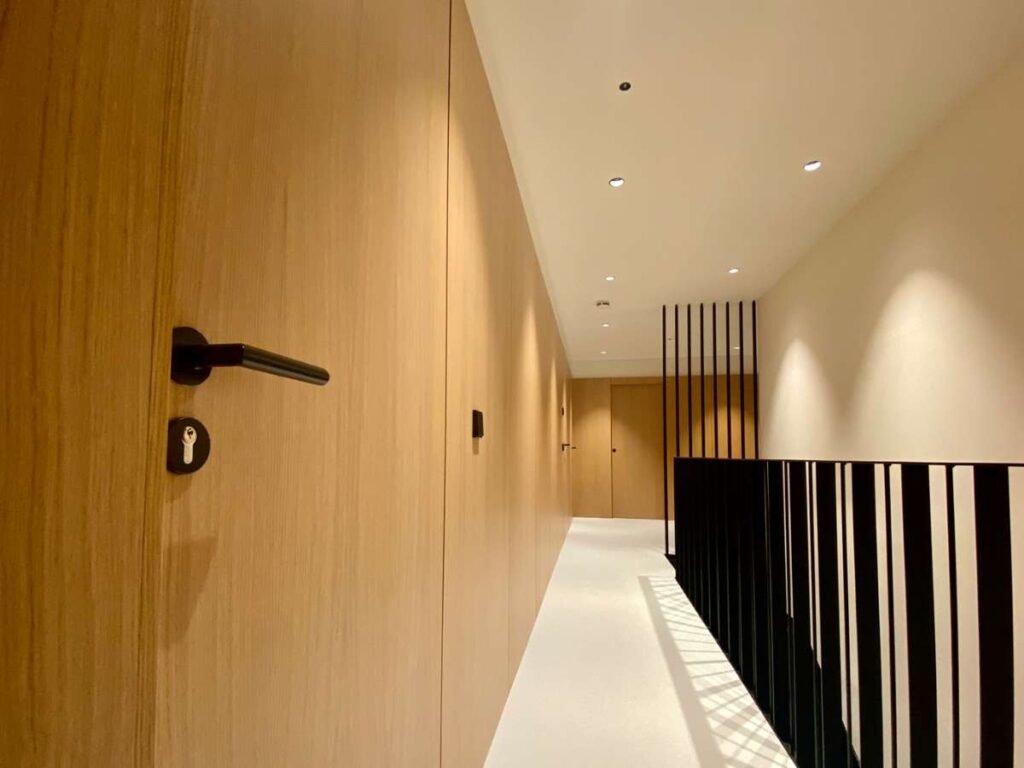
2. Acoustic Solid-Core Doors: Quiet Rooms, Happy Guests
I once stayed in a city hotel where I could hear the elevator ding from inside my room. Every hallway conversation, every cart rolling past, came right through the door. It made me realize how much a poorly built door can affect a guest’s comfort. Acoustic solid-core doors solve this problem by blocking noise and creating a more peaceful stay.
A solid-core door is built with a dense interior rather than being hollow. The added weight helps absorb and reduce sound. In hotels, this can mean the difference between a restful night’s sleep and a restless one.
Key Features
- Superior Sound Insulation: The dense core blocks sound waves more effectively than hollow designs. Guests benefit from reduced hallway and neighboring room noise.
- Increased Privacy: These doors limit the transfer of conversations and other sounds. This creates a sense of security and comfort for guests.
- Substantial Feel: The extra weight gives the door a solid, high-quality feel when opened or closed. This leaves a lasting impression on guests.
Material and Finish Options
- Solid Wood Cores: Offers excellent sound dampening and a premium appearance. Suitable for luxury and upscale properties.
- Composite Cores: Combines engineered materials for a balance of performance and cost. Works well for large-scale hotel projects.
- Laminates and Veneers: Provides style flexibility with finishes that match your property’s design theme.
Installation and Maintenance Notes
- Proper Sealing: Acoustic performance depends on high-quality seals around the frame. Regular checks keep the seal effective.
- Hardware Durability: Heavier doors require strong hinges and handles. Routine inspections prevent wear and maintain smooth operation.
Why Choose This Design
Acoustic solid-core doors are perfect for hotels where noise reduction is a priority. They not only improve guest comfort but also elevate the perceived quality of your property. Vallisco offers solid-core and soundproof door options that meet high hospitality standards, helping your guests sleep well and leave with lasting positive impressions.
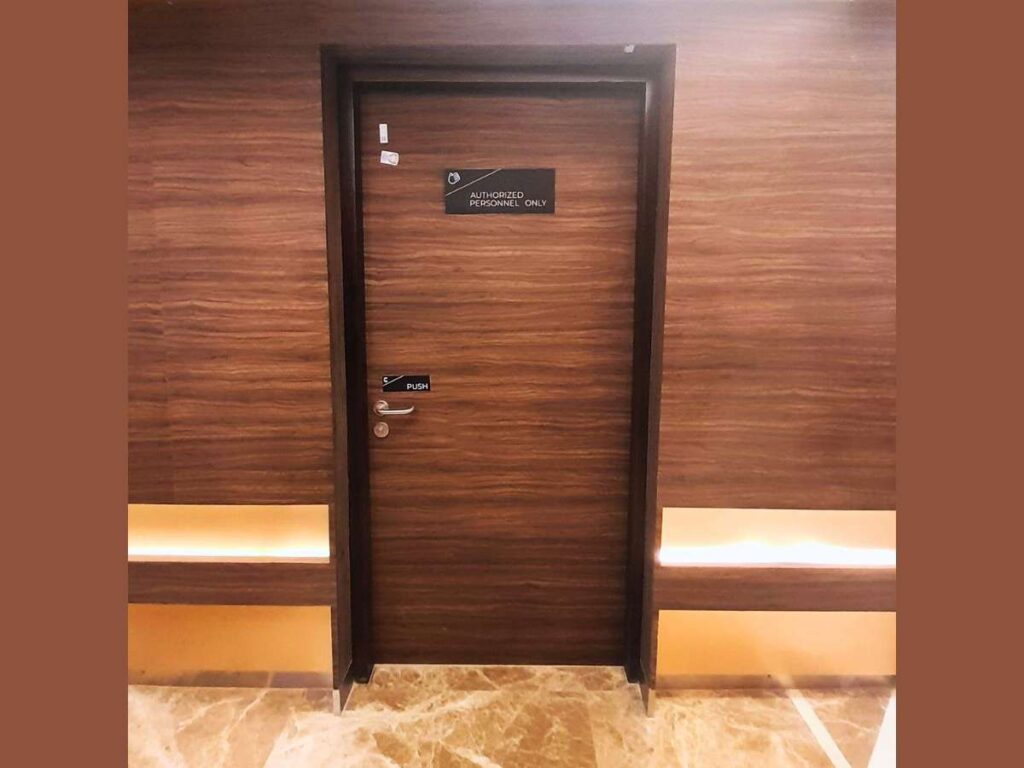
3. Custom Carved Wooden Doors: Add Warmth and Personality
I once visited a boutique hotel in a historic district where every guest room door had a unique carved pattern. The designs reflected the city’s culture, and each one told a story before you even stepped inside. It felt personal, as if the door itself was part of the experience. Custom carved wooden doors can bring that same sense of identity to your property.
These doors are made by hand or machine, with patterns, motifs, or textures carved directly into the wood. The detail can be shallow and subtle or deep and dramatic, depending on your vision. In hotels, they act as both functional entries and decorative features.
Key Features
- Distinctive Design: Carvings can reflect local culture, your brand story, or a theme. This gives guests something memorable to associate with your property.
- Visual Depth: The patterns create shadows and texture that make the door stand out. This adds dimension to your corridors.
- Premium Appeal: Handcrafted or finely machined carving signals care and attention in the property’s design. Guests notice that level of thought.
Material and Finish Options
- Solid Hardwoods: Oak, teak, and mahogany offer strength and hold detailed carvings well. These woods also age beautifully.
- Custom Stains and Paints: Highlight the carving details or match the hotel’s color palette. Stains can enhance the grain for added richness.
- Protective Sealants: A clear layer protects against wear in high-touch areas. This also keeps dust from settling deeply into the grooves.
Installation and Maintenance Notes
- Regular Cleaning: Dust and debris can settle in carvings. A soft brush or cloth keeps them clean without damaging the finish.
- Placement Choice: Works best in areas where guests have time to notice details, such as premium rooms or themed sections. Skilled installers are important to prevent damage during fitting.
Why Choose This Design
Custom carved wooden doors give your property personality that guests will remember. They combine beauty with the function of a solid, secure entry. When done well, they turn something ordinary into a highlight of the guest experience.
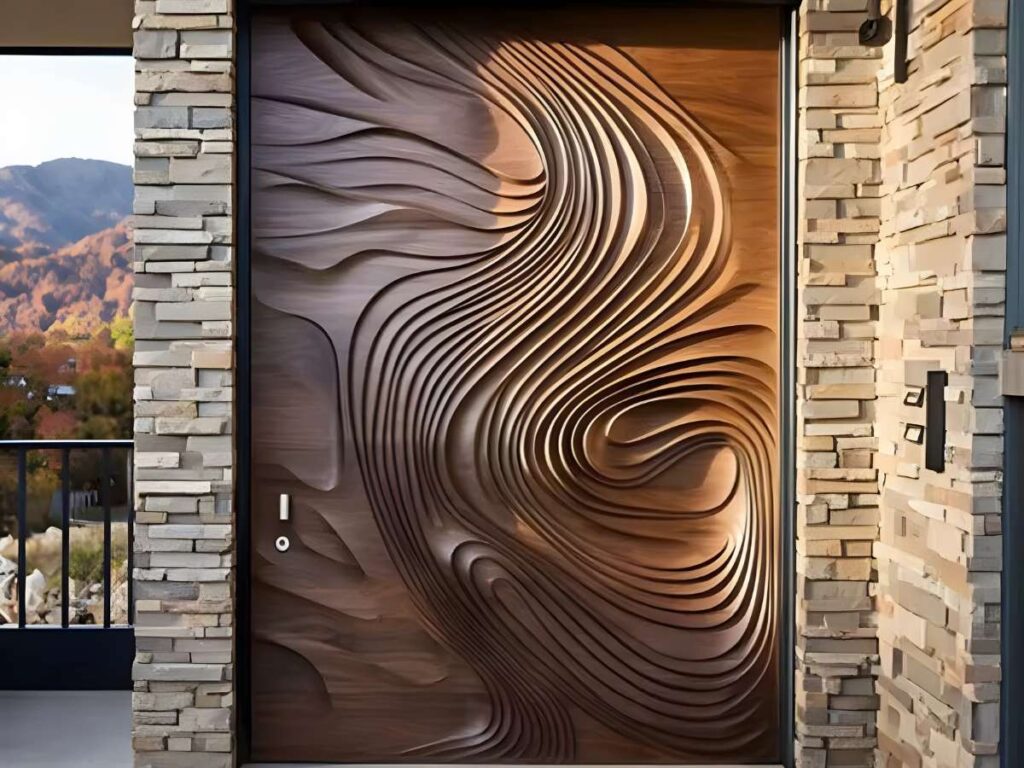
4. Frameless or Hidden Doors: Seamless and Modern Look
I once toured a newly built luxury hotel where the doors blended so seamlessly into the walls that I had to look twice to find the entrance. The effect was striking. It gave the hallway a smooth, uninterrupted look that made the whole space feel more refined. Frameless or hidden doors can create this same sense of sophistication in your property.
These doors are designed to sit flush with the wall, with no visible frames or trims. The hinges are concealed, and the surface can be finished to match the wall’s color or texture. The result is a door that becomes part of the architecture rather than a separate element.
Key Features
- Seamless Appearance: The door blends into the wall for a clean, minimalist look. This works well in properties that value a modern design approach.
- Hidden Hardware: Concealed hinges and flush handles keep the surface uncluttered. This adds to the streamlined feel.
- Design Flexibility: The surface can be painted, veneered, or covered with wallpaper to match the surrounding decor.
Material and Finish Options
- MDF Panels: Medium-density fiberboard offers a smooth base for paint or veneer. It is also stable and resists warping.
- Matching Veneers: Wood veneer surfaces can continue the look of surrounding wall panels. This adds warmth while keeping the hidden effect.
- Painted Finishes: Color-matched paint allows the door to disappear into the wall completely. This works well in minimalist settings.
Installation and Maintenance Notes
- Precision Fit: The door frame and hinges must be aligned perfectly for the hidden effect to work. Skilled installation is essential.
- Regular Alignment Checks: Concealed hinges can shift slightly over time. Routine adjustments keep the door operating smoothly.
Why Choose This Design
Frameless or hidden doors give your property a modern, high-end atmosphere. They create a sleek look that appeals to guests who appreciate design details. When executed well, they make space feel carefully crafted and visually harmonious.
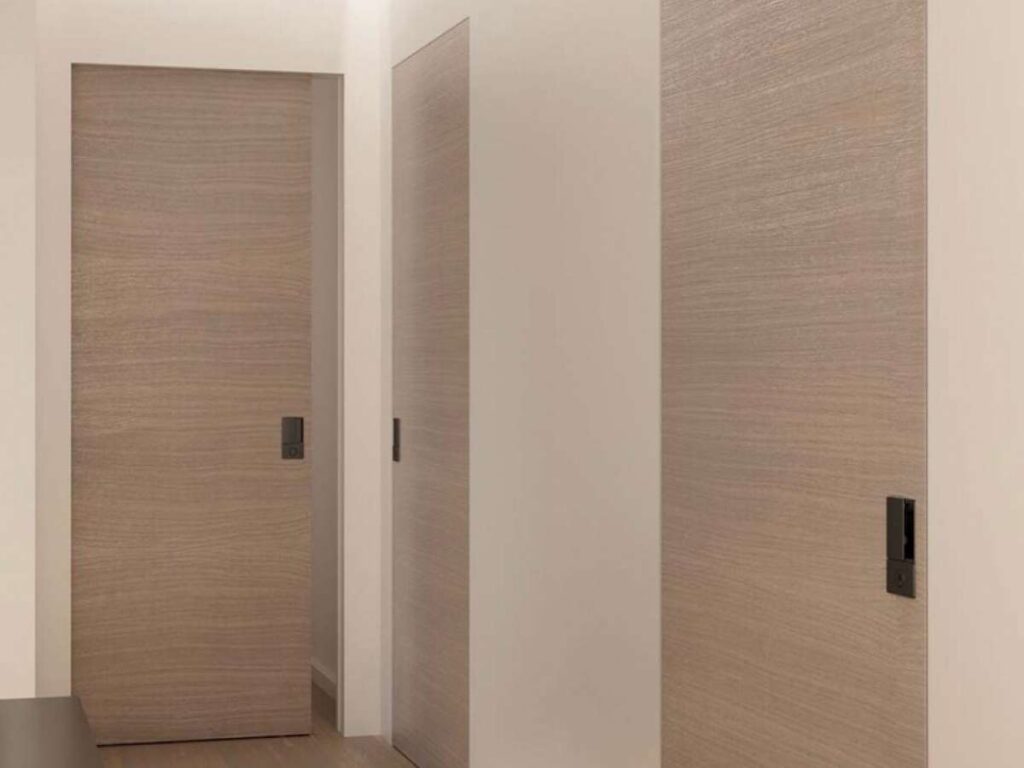
5. Sliding Barn-Style Doors: Space-Saving with a Statement
I remember staying in a mountain lodge where each room had a sliding barn-style door. The solid wood panel rolled silently along its track, revealing the bathroom behind it. It added charm to the room while saving space, and I found myself admiring how practical it was. Sliding barn-style doors can give hotels that same blend of character and function.
These doors move along a mounted track instead of swinging open. This makes them a good choice for rooms where floor space is limited. They can be rustic, industrial, or contemporary depending on the materials and hardware you choose.
Key Features
- Space-Saving Design: Since the door slides parallel to the wall, there’s no need for clearance space. This makes them ideal for compact rooms or suites.
- Versatile Style: The same basic mechanism works with wood, glass, or metal panels. This allows the door to match different themes within your property.
- Smooth Operation: Quality rollers and tracks allow for a quiet, effortless glide. This keeps the movement from disturbing guests.
Material and Finish Options
- Solid Wood Panels: Offers warmth and a traditional look. Works well in rustic or lodge-style hotels.
- Glass with Frames: Brings in more light while still providing separation. Frosted or tinted glass can offer privacy.
- Metal Accents: Adds an industrial feel and pairs well with contemporary spaces. Durable finishes resist wear in high-traffic areas.
Installation and Maintenance Notes
- Track Stability: The track must be anchored securely to handle daily use. Proper installation prevents sagging or misalignment.
- Regular Roller Checks: Over time, rollers can collect dust or debris. Cleaning and occasional lubrication keep them moving smoothly.
Why Choose This Design
Sliding barn-style doors combine visual appeal with space efficiency. They offer flexibility in design, fitting into both rustic and modern interiors. When installed well, they can become a signature feature that guests remember long after they check out.
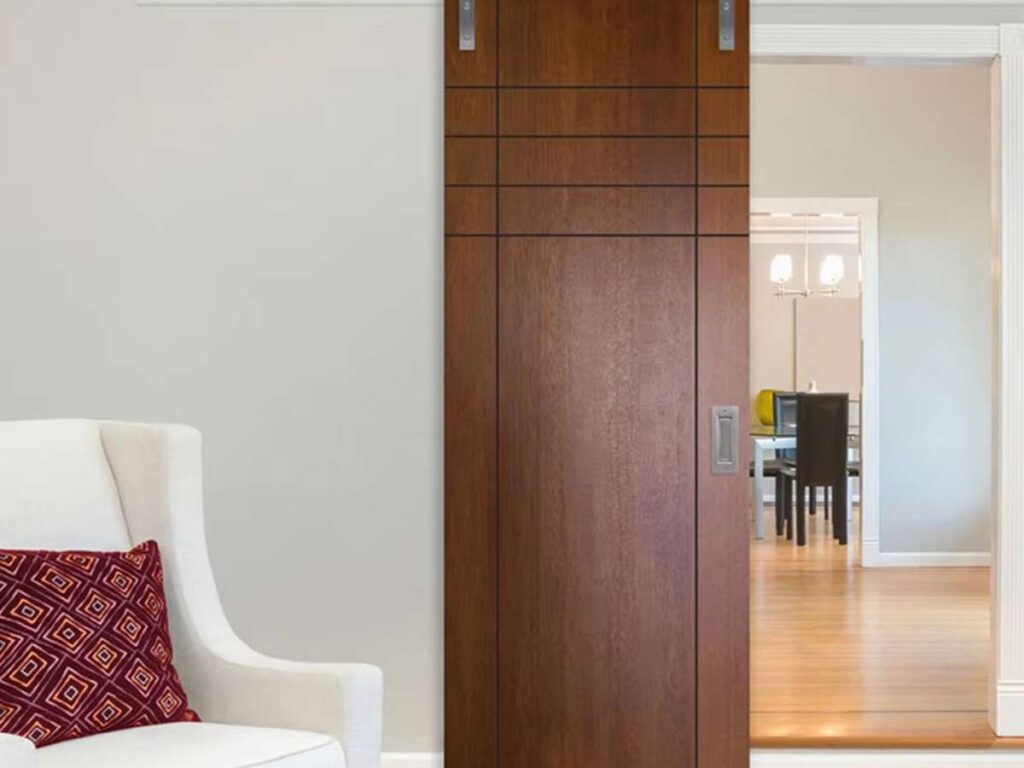
6. Mirror-Panel Doors: Function Meets Illusion
Guests often walk into a room and instantly notice how spacious it feels. In many cases, the difference comes from a simple design choice: a mirror-panel door. The reflection adds depth, spreads light, and creates a brighter, more inviting atmosphere without major construction changes.
A mirror-panel door is a standard door fitted with a mirror on one or both sides. It is both decorative and functional. In hotels, it gives guests a built-in full-length mirror for convenience while enhancing the overall look of the room.
Key Features
- Visual Space Enhancement: Mirrors make rooms appear larger by reflecting walls and furnishings. This helps smaller spaces feel more open and comfortable.
- Dual Functionality: Serves as both an entryway and a practical grooming aid. Guests can check their appearance without leaving the room.
- Light Reflection: Distributes natural and artificial light evenly. This can reduce the need for additional lighting during the day.
Material and Finish Options
- Framed Mirrors: Adds a decorative border that ties into the room’s interior design. Options include wood, metal, or composite materials.
- Frameless Mirrors: Provides a clean, contemporary look where the glass flows seamlessly with the door surface.
- Tinted or Frosted Glass: Offers subtle styling and can reduce glare. Frosted finishes can also add a soft decorative element.
Installation and Maintenance Notes
- Safety Glass: Tempered or laminated glass is recommended to minimize injury risk if the mirror breaks.
- Routine Cleaning: Mirrors show smudges easily, so regular cleaning with non-abrasive products keeps them clear and presentable.
Why Choose This Design
Mirror-panel doors combine functionality with a touch of elegance. They help rooms feel more spacious and welcoming while serving a daily guest need. For hotels wanting a design element that works hard without taking extra space, this option delivers both form and purpose.
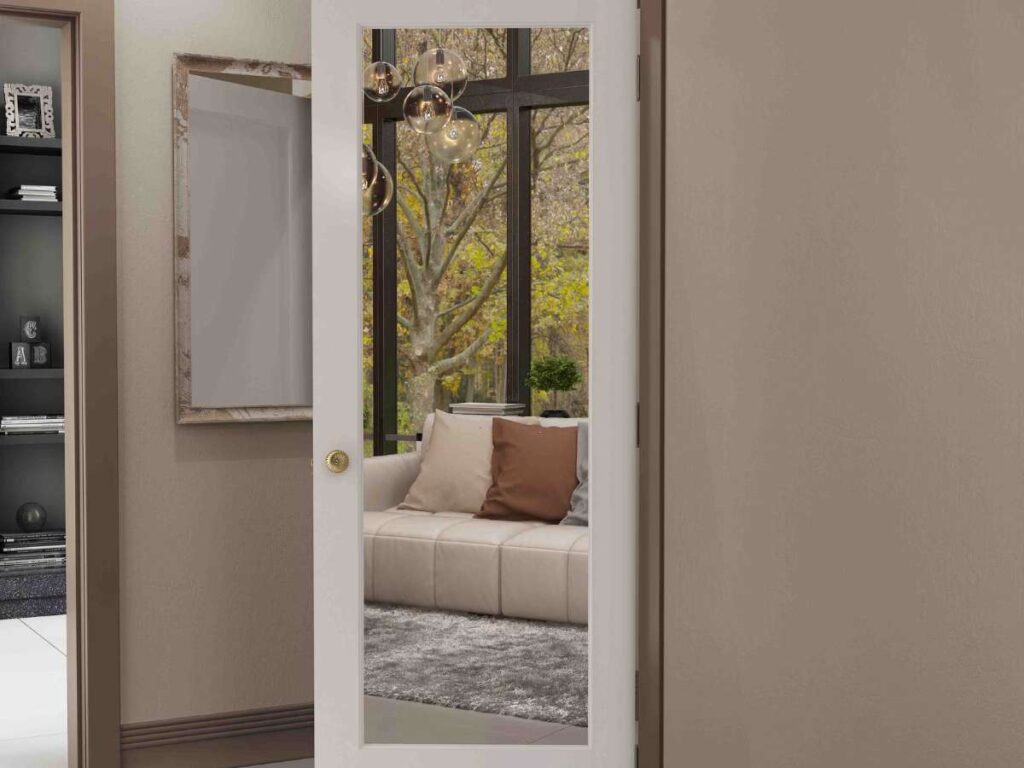
Final Tips Before Choosing a Hotel Room Door Design
Picking a hotel room door might seem straightforward at first. Once you start comparing materials, finishes, and features, the process can quickly become more complex. We’ve worked with hotels on both new builds and upgrades, and every project has its own challenges. If you’re still deciding, here are some tips to guide you.
- Focus on Guest Experience: Decide what atmosphere you want guests to feel when they walk in. Whether it’s quiet, welcoming, modern, or space-saving, the right door design sets the tone immediately.
- Visualize the Room Walk-Through: Imagine stepping into the room as a guest. Think about what feels natural and what might cause inconvenience or distraction.
- Plan for Daily Use: A door’s look matters, but it also needs to perform under constant use. Consider weight, sound control, durability, and ease of cleaning before finalizing your choice.
- Match Hardware and Frames: Make sure the hinges, locks, and frames are suited for the chosen door style. A heavier or more complex design may need specialized hardware.
- Account for Construction Requirements: Some styles, such as frameless or sliding doors, require wall preparation before installation. Deciding late in the process can lead to higher costs or changes in design.
- Involve Builders Early: A quick consultation with your installer or contractor can prevent costly mistakes. Early planning helps you understand what’s possible and ensures the project runs smoothly.
Vallisco has helped hotels across Southeast Asia and Europe select doors that combine style, durability, and guest comfort. If you want practical solutions that work for your property’s layout, design, and budget, our team can guide you every step of the way.
Conclusion
The room may start at the bed but the experience begins at the door. You’ve now seen 6 hotel room door designs that work in real life.
They look good, function well, and solve everyday problems.
So, where do you begin? Start with what your guests need. Then choose the door that fits your space, your style, and your budget.
I’ve helped clients turn ideas into real results one door at a time.
Still not sure what fits your project?
Let Vallisco guide you. Contact us today.
Recommended Reads for You
Interested in more? Here are some additional articles with insights and tips to keep you informed:
Still haven’t found what you’re looking for? Don’t hesitate to contact us. We’re available around the clock to assist you.







